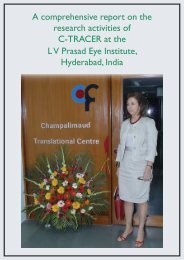Relatório Anual 2010 - Fundação Champalimaud
Relatório Anual 2010 - Fundação Champalimaud
Relatório Anual 2010 - Fundação Champalimaud
You also want an ePaper? Increase the reach of your titles
YUMPU automatically turns print PDFs into web optimized ePapers that Google loves.
Thiago Gouvêa (PhD Student)Hope Johnson (Postdoctoral Fellow)Magor Lorincz (Postdoctoral Fellow)Sara Matias (PhD Student)André Mendonça (PhD Student)Masayoshi Murakami (Postdoctoral Fellow)Maria Inês Vicente (PhD Student)We are interested in understanding the principles underlying the complexadaptive behavior of organisms. Starting with quantitative observations ofanimal behavior, we aim to integrate quantitative cellular and systems levelexperimental analysis of underlying neural mechanisms with theoretical,ecological and evolutionary contexts. Rats and mice provide flexibleanimal models that allow us monitor and manipulate neural circuits usingelectrophysiological, optical and molecular techniques. We have madeprogress using highly controlled studies of a simple learned odor-cueddecision task and are extending our focus toward more complex behaviors.Projects in the lab are wide-ranging and continually evolving. Current topicsinclude (i) olfactory sensory decision-making, (ii) the function of the serotoninsystem, (iii) the role of uncertainty in brain function and behavior.Optogenetic identification and control of serotonin neurons in behavinganimalsSerotonin is an important neurotransmitter implicated in a wide varietyof physiological functions and psychopathologies, but whose function isnot well understood. Critically, very little is known about the activity ofserotonin-releasing neurons in the brain. To address this problem, we areusing optogenetic tools that target this class of cells via specific promotersto selectively monitor, stimulate and inhibit serotonin neurons. We aim totest specific hypotheses concerning the role of serotonin in brain functionand behavior.In the past year, we focused on validating and improving our techniquesfor expressing light-gated channel channelrhodopsin-2 (ChR2) in 5-HTneurons. We tested our custom adeno-associated virus (AAV) in rats andcompared it to a double-floxed inverted ORF (DiO) strategy in the mouse.With this improved tool in hand, we are now testing the behavioral effectsof stimulating 5-HT neurons.In parallel, we produced an AAV for specifically expressing the calciumsensor GCaMP3 in 5-HT neurons and developed a custom fiberoptic lightdetection system, which we will use to measure fluorescence changes infreely moving rats and mice.FC Relatório <strong>Anual</strong> <strong>2010</strong> 26



